Summer news from PWA counties
What a wild ride 2020 has been so far! The pandemic turned the world as we know it upside down. So many things have changed — a few of them positive. One good thing to come out of self-isolation is seeing friends and neighbors planting gardens and discovering wildflowers. Victory gardens in 5-gallon buckets and colorful pollinator patches have sprung up all around my neighborhood in Tallahassee.
The Florida Wildflower Foundation also is adapting to new norms. We are now offering virtual presentations on the importance of wildflowers along roadsides and in our home landscapes, and are developing webinars such as how to request conservation of roadside wildflower populations. Contact me at 850-570-5950 to learn more or to request a virtual presentation.
On June 6, the Foundation and the Florida Native Plant Society (FNPS) signed a Memorandum of Understanding during FNPS’ virtual annual membership meeting. The two organizations will collaborate to promote the shared goal of conserving wildflowers and native plants, especially along roadsides.
Around the Panhandle, wildflower advocates are doing inspiring things to conserve wildflowers and promote corridors that create and connect habitat. Volunteers have planted native wildflowers, shrubs and trees in community gardens in Blountstown, Sopchoppy and Tallahassee. These public habitat enhancements are attracting wildlife and pollinators and gaining positive feedback from their communities. We hope they inspire homeowners to add native plants to their home landscapes.
– Liz Sparks, FWF Regional Alliance Liaison
What’s new in FDOT District 3
Text and photos by Bob Farley
After the destruction from Hurricane Michael and the subsequent removal of debris from the Interstate 10 median in Jackson County between the Sneads and Grand Ridge interchanges, the Florida Department of Transportation decided to restore vegetative cover in an open meadow rather than reforest the area. This multi-year effort will be implemented in phases, beginning with the introduction of native wildflower seed. Species were selected by habitat type and sowed into the existing seed bank without herbicide pre-treatment.
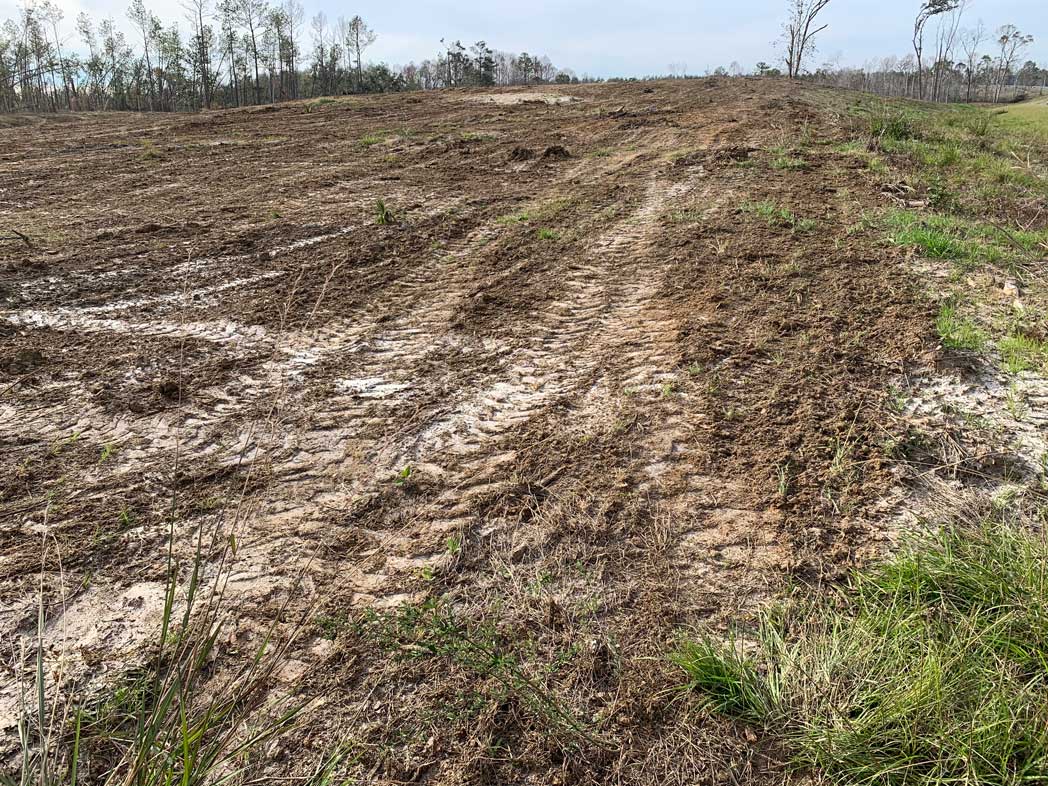
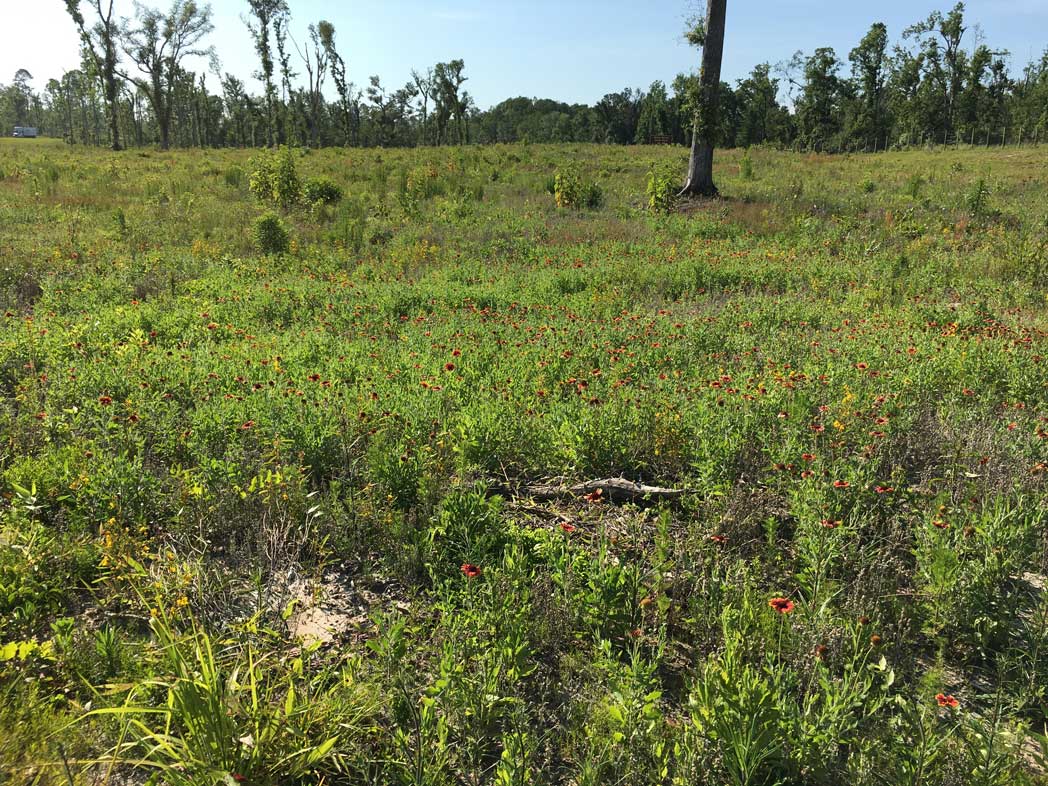
As anticipated, results varied, with showy wildflower displays in some parts of the 90-acre site. Other parts succumbed to pressure from the weed seed bank. Emerging species were monitored, resulting in a list of desirable naturally occurring native plants, including Florida phlox (pictured below) and undesirable weed species that threaten to overtake the site. Phase 2 includes an ongoing program of targeted herbicide treatments to reduce undesirable species while preserving both naturally occurring and seeded desirable species.
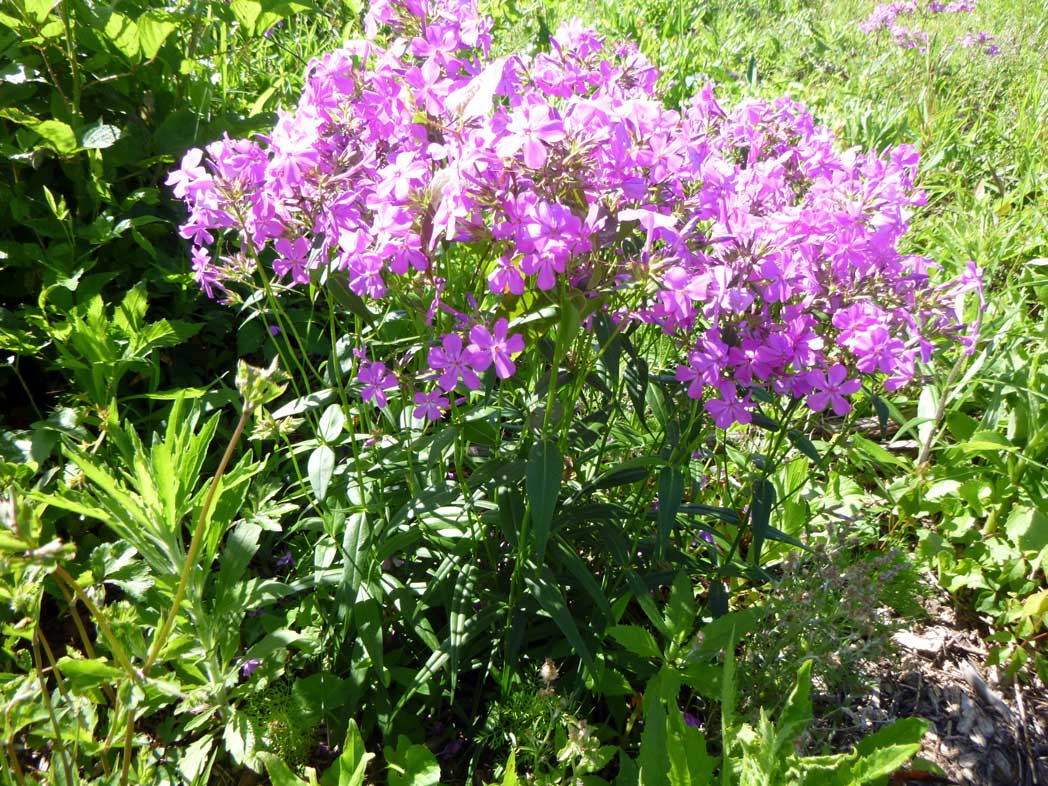
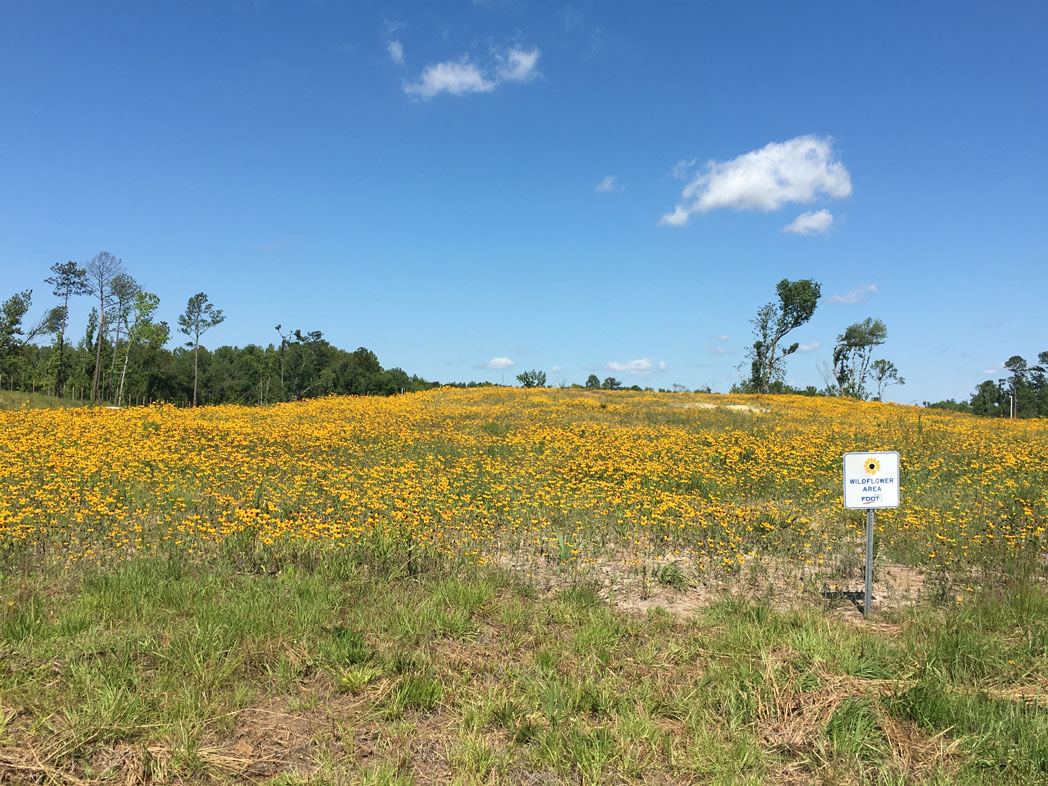
Apalachee Bees Research Project
By Rachel Mathes, Horticulture Program Assistant, UF/IFAS Leon County Extension
Apalachee Bees is a research project in North Florida that monitors bees and the plants they visit throughout the year to create a calendar of bloom times. This localized calendar will be useful for providing local plant recommendations for the Apalachee Beekeepers Association and wildlife gardeners throughout the Panhandle.
Apalachee Bees has two aspects: an iNaturalist project for data collection and a behind-the-scenes spreadsheet for identification and analysis by Leon County Master Gardener volunteers. The iNaturalist project is collecting observations of bees and wasps on flowers in Northwest Florida from Jefferson to Escambia counties between January 2017 and the end of 2020. iNaturalist users don’t even have to submit their entry to the project; it’s automatic. Observations and plant identifications are then recorded on a spreadsheet, with data divided by county and month. Scientific and common names of both insect and plant are recorded, along with the county and date of observation and a link to the entry so users can double-check one another on plant identifications. Many of the plants are recorded in people’s home gardens, and while cultivated plants are typically excluded in iNaturalist projects, we are interested in all flowers visited by bees.
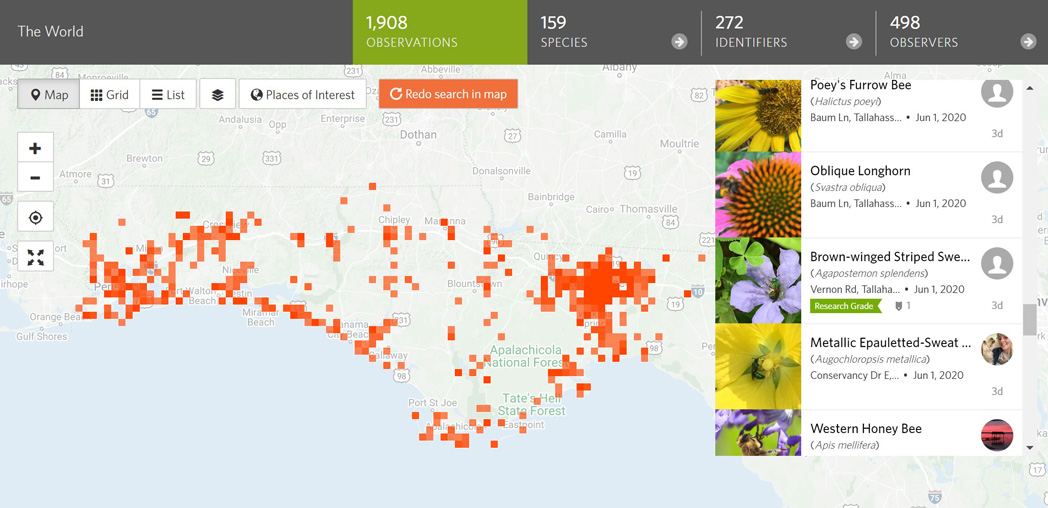
The goal of the project is to provide a list of bee-favorite plants gardeners can plant to support the more than 300 species of native bees — and Honey bees, too. So far, we have nearly 2,000 observations between 500 observers with 159 species represented. The most prominent entries are Honey bees (Apis mellifera), which are an introduced species. Second and third are the Eastern bumblebee (Xylocopa virginica) and Eastern carpenter bee (Bombus impatiens), two industrious native species.
This project has been a fun way to engage Master Gardener volunteers in plant identification, data collection and, eventually, data synthesis, which will begin in 2021.
What’s Happening Around the Panhandle
Calhoun County
Text and photo by Liz Sparks
The Blountstown Depot Garden, planted in November 2019 by volunteers, is flourishing, with many of the plants looking robust. Karen and Travis MacClendon have been wonderful guardians of the garden, keeping a close eye on it by visiting at least once a week and watering and weeding as needed. Karen also is developing a list of butterflies attracted to the diverse native flora.
In early May, a small team of volunteers from the Foundation and the FNPS Magnolia Chapter met to weed the beds and add durable plant labels with both common and scientific names. They were joined by Dr. Loran Anderson, who was excited to identify and voucher Green amaranth (Amaranthus viridis), a weedy visitor in one of the flower beds. According to Anderson, “Even weeds can be interesting. Green amaranth is a cosmopolitan weed but is edible. Leaves contain up to 38% protein by dry weight. The leaves and seeds contain lysine, an essential amino acid.”
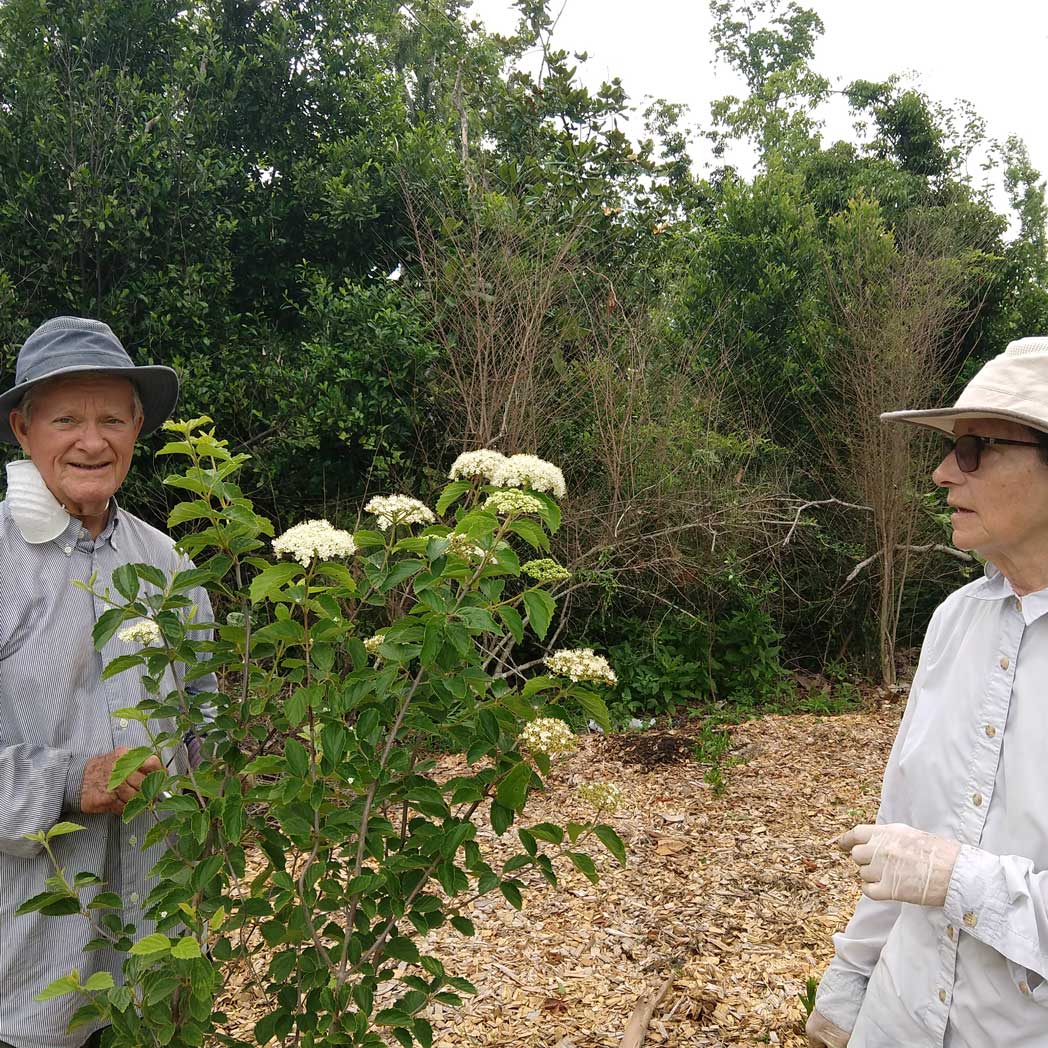
Franklin County
Leslie Cox, lead PWA volunteer for Franklin County for several years, is stepping back from her duties. The Foundation is grateful for her dedication and hard work to conserve Franklin County’s wildflowers and natural resources. Thank you so much, Leslie!
We are pleased to introduce Anita Grove, coastal training program coordinator at Apalachicola National Estuarine Research Reserve, and her staff, who are stepping up to take over the PWA leadership role for the county’s wildflower program. The reserve’s mission is to promote and practice informed stewardship of upland and aquatic resources to conserve the area’s natural biodiversity and cultural resources through applied research and education. They fully appreciate the importance of local wildflowers to pollinators. Franklin County has long valued its roadside wildflowers.
The reserve’s popular Bay-Friendly Landscaping program, modeled after the UF/IFAS Florida-Friendly Landscaping program, uses the roadsides as a teaching aid. The reserve also has a demonstration garden at its Eastpoint facility that includes native wildflowers and a milkweed garden. Learn more about the reserve here.
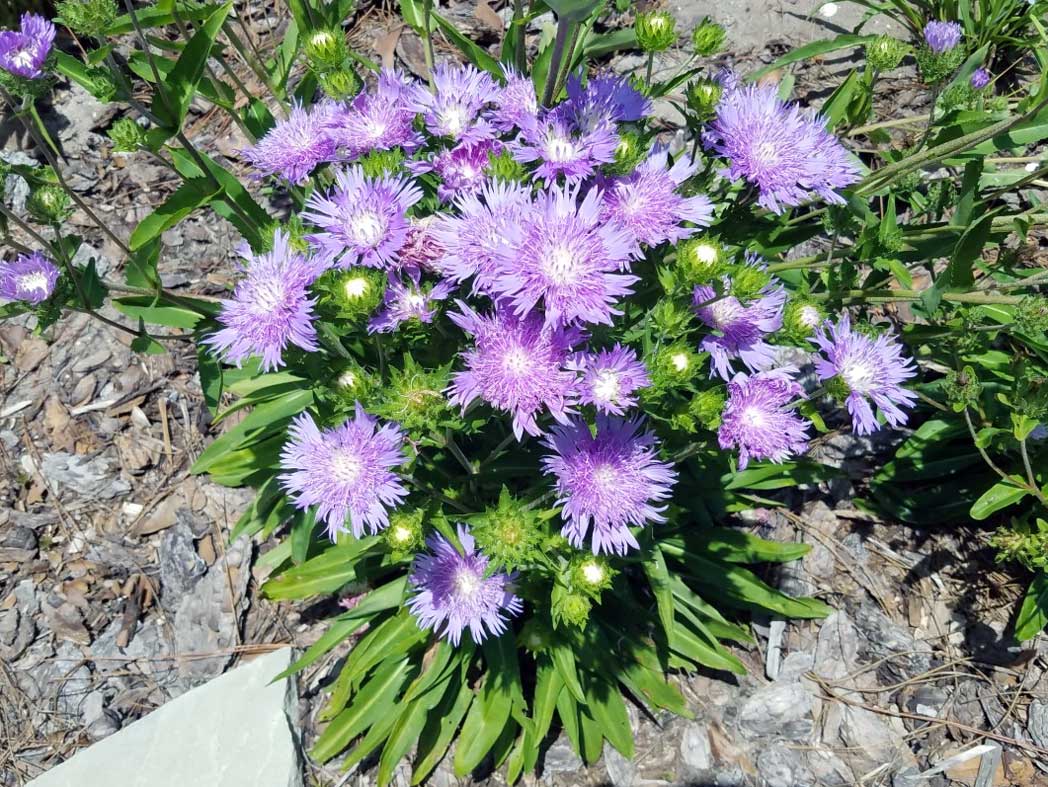
Leon County
Text and photos by Liz Sparks
Lake Elberta City Park in Tallahassee is a secluded urban park nestled between two major universities. It attracts joggers, cyclists, birders and wildlife. Its stormwater retention pond, with its with paved trail, has been transformed into a birding hotspot and wildlife oasis. Through a partnership of the Apalachee Audubon Chapter and the City of Tallahassee, volunteers and interns have planted native trees and wildflowers, removed invasive species, and built nesting boxes. Colorful pollinators now flit between Black-eyed Susans (Rudbeckia hirta), Blanketflower (Gaillardia pulchella) and other attractive wildflower species along portions of the trail, enhancing a visitor’s experience.
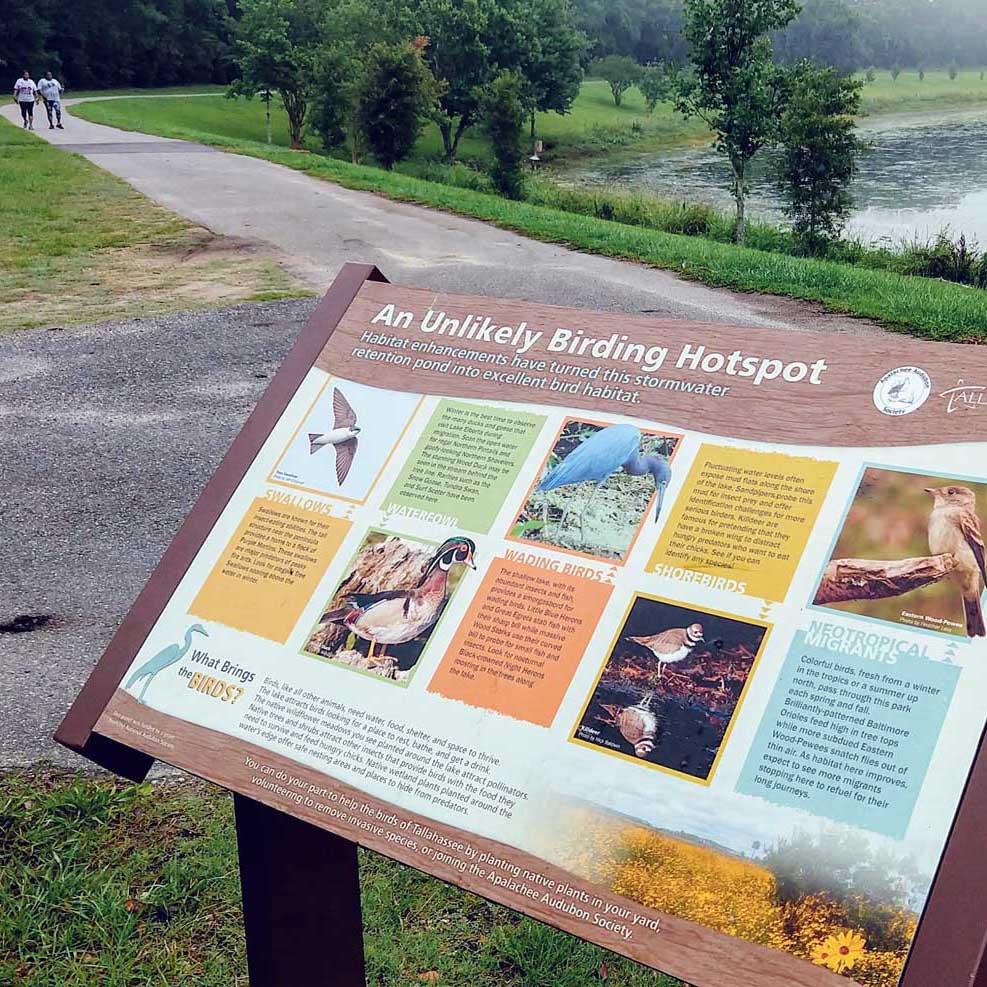
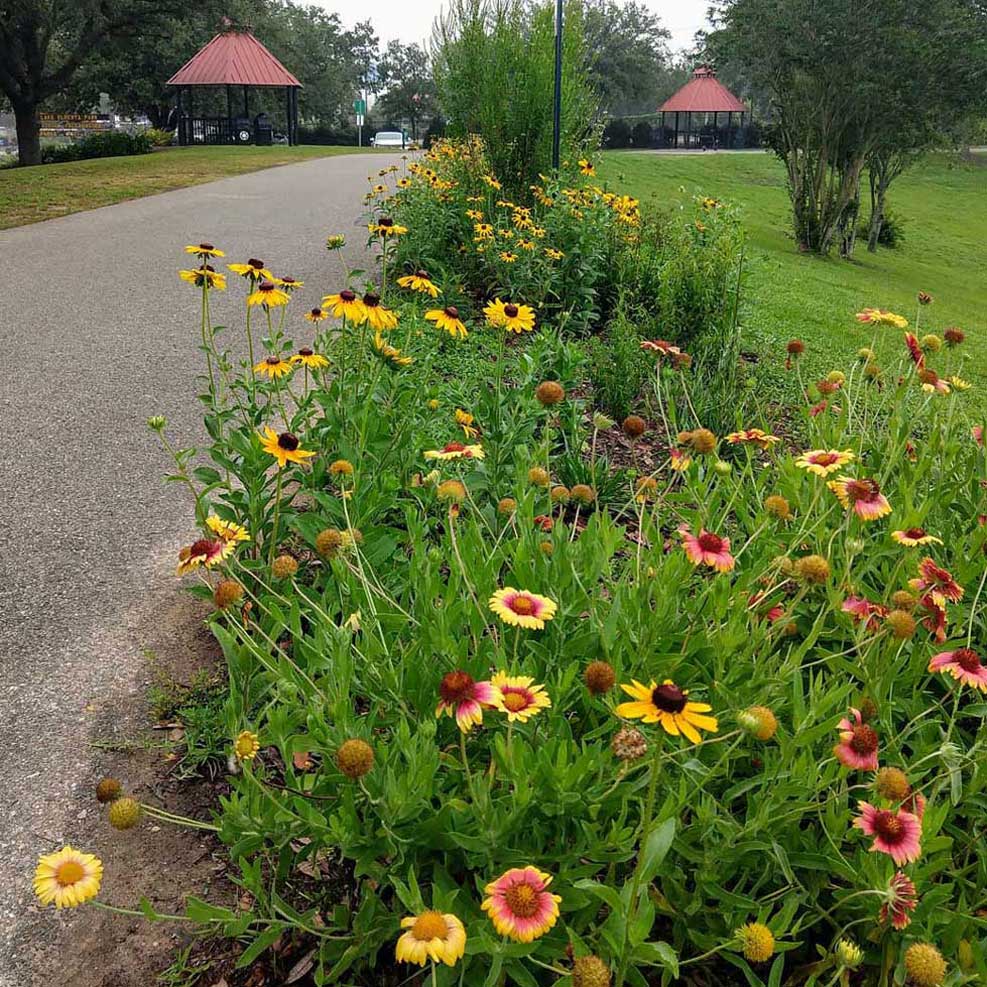
Santa Rosa County
Suzanne Spencer reports, “I was surprised to receive this very nice letter from County Administrator Dan Schebler just the other day and wanted to share it with you. We are fortunate to have people at the county level who are so supportive of our Roadside Wildflower Conservation Program!”
In the letter, the county recognized the $210,000 savings to taxpayers over three years through reduced mowing of the backslopes along roadsides. What great news!
Click the image to read the letter.
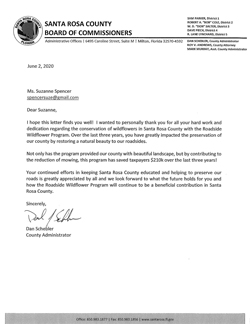
Wakulla County
Text and photo by Lynn Artz
In April, the City of Sopchoppy applied to the Monarch-Milkweed Initiative at St. Marks National Wildlife Refuge to request its Depot Park be selected to receive native milkweed plants. Several weeks later, the city was informed that their application was approved and they would receive the 114 plants requested: 45 Sandhill milkweed (Asclepias humistrata), 10 Velvetleaf milkweed (Asclepias tomentosa), 12 White swamp milkweed (Asclepias perennis), 12 Pink swamp milkweed (Asclepias incarnata), 25 Redring milkweed (Asclepias variegata) and 10 Anglepod milkvine (Gonolobus suberosus).
On May 9, volunteers planted the Velvetleaf milkweed and Anglepod milkvine plants. The remaining seedlings will be planted later this summer and fall. This will expand the milkweed planted in 2018 and 2019. Although the park is small, studies suggest that such a site may yield a greater number of Monarch eggs per plant.
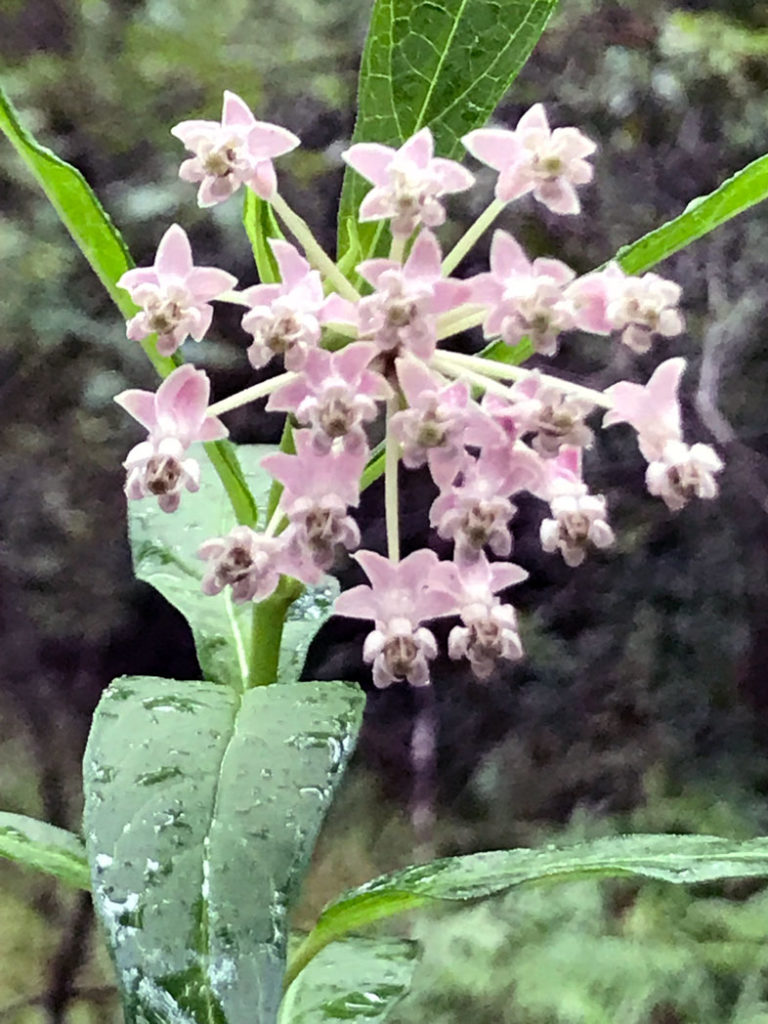
U.S. 319 plant rescue
by Gail Fishman
During his excursions locating and mapping significant roadside plants, Scott Davis is especially mindful of roads that are soon to be impacted by construction. He has been surveying U.S. Highway 319 for at least three years and found many populations of milkweed, listed plants and plants important to pollinators.
The Florida Department of Transportation (FDOT) is responsible for scheduling, designing and constructing new roads and modifying existing highways at the state level. Projects are usually scheduled several years in advance so the public should know when the work is to begin. Work had already begun to widen U.S. 319 near Crawfordville when we scheduled a meeting with Project Administrator Jerry McClure to set up time to remove plants ahead of bulldozers. FDOT is in favor of saving the plants and protecting pollinator habitat, but we had to make sure we would not interfere with their contractor’s work schedule.
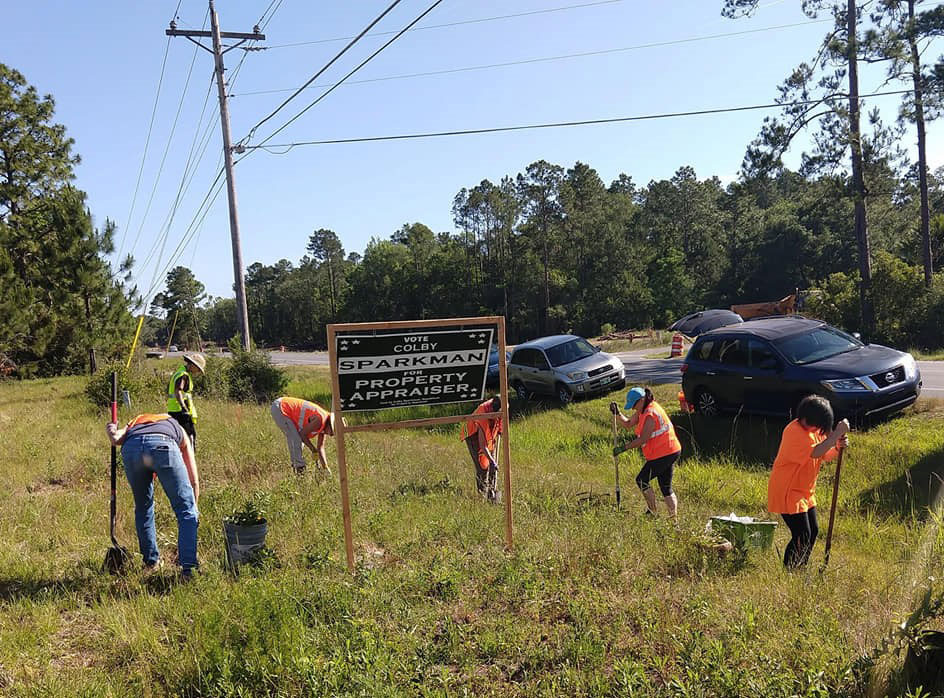
Scott began contacting volunteers, and the response was overwhelming. We met over four days. People came from the surrounding area and as far away as Pensacola and Ocala. It was very heartening to see so many people share their time and muscles to save the plants.
Scott is in the process of lining up a recipient site for the state-threatened Southern crabapple (Malus angustifolia). Other species rescued were Butterfly milkweed (Asclepias tuberosa), Clasping milkweed (A. amplexicaulis), Whorled milkweed (A. verticillata), at least two species of Blazing star (Liatris spp.), Passionvine (Passiflora sp.), Wiregrass (Aristida sp.), Tickseed (Coreopsis sp.), Spiderwort (Tradescantia sp.), and 27 little Longleaf pines (Pinus palustris). Some of the Passionvines, which are a host plant for Zebra longwing and fritillary butterflies, had caterpillars that completed their life stages to emerge as butterflies.
We are grateful to FDOT for the opportunity to save the plants and to everyone who came out to help.
Scott manages the Monarch-Milkweed Initiative at St. Marks, a project dedicated to growing and providing milkweed plants to partners. A few days after the plant rescue, he and milkweed intern Megan Nichols delivered 800 young milkweed plants to Cascades Park in Tallahassee. City of Tallahassee employees planted them, and they will soon begin growing and attracting many different pollinators in addition to providing food for Monarch caterpillars. Milkweeds produce a lot of nectar important for other butterflies, bees, wasps, beetles and other insects.
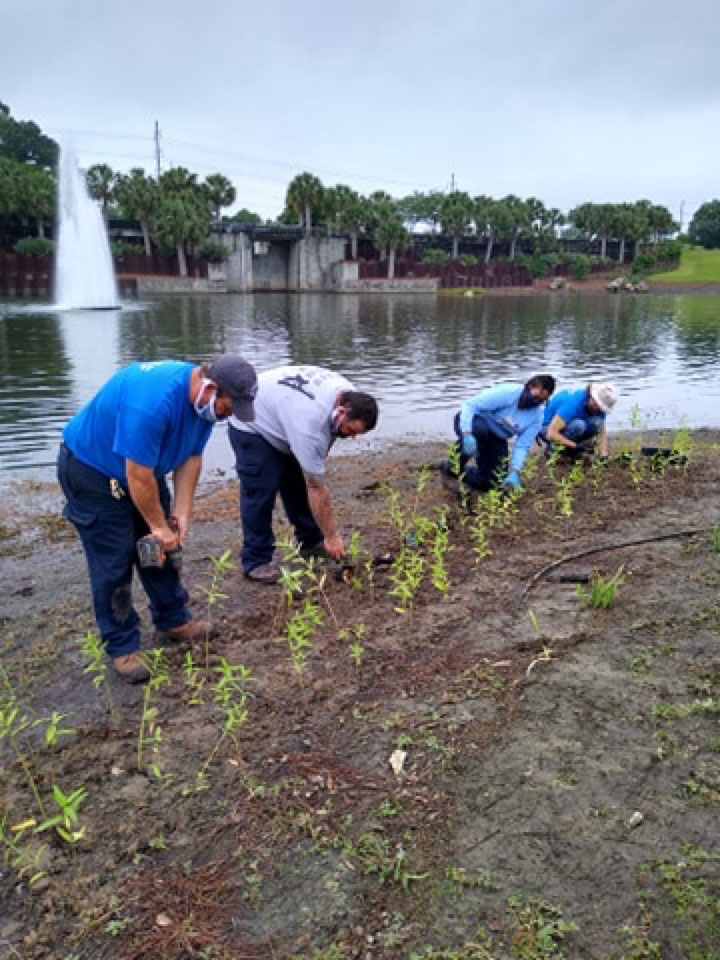
Photo by Megan Nichols
